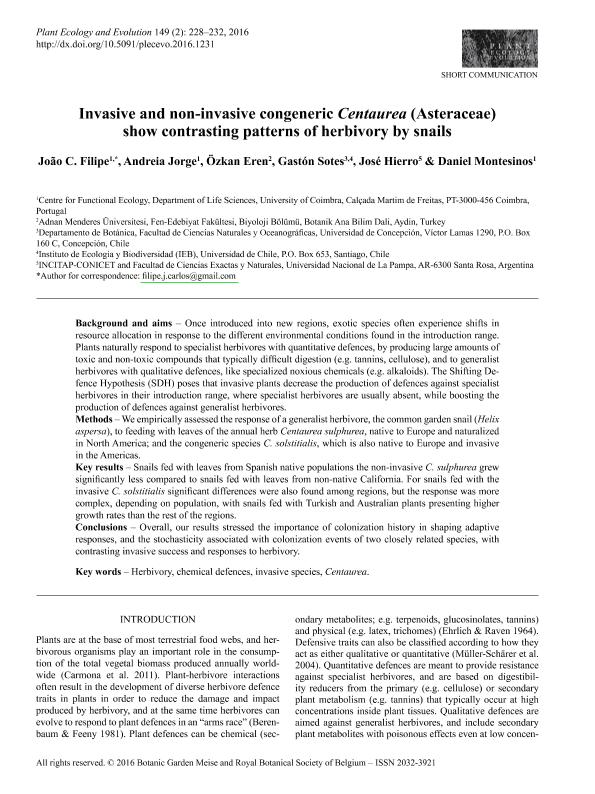Mostrar el registro sencillo del ítem
dc.contributor.author
Filipe, João C.
dc.contributor.author
Jorge, Andreia
dc.contributor.author
Eren, Ozkan

dc.contributor.author
Sotes, Gastón
dc.contributor.author
Hierro, Jose Luis

dc.contributor.author
Montesinos, Daniel
dc.date.available
2017-07-05T17:35:53Z
dc.date.issued
2016-07
dc.identifier.citation
Filipe, João C.; Jorge, Andreia; Eren, Ozkan; Sotes, Gastón; Hierro, Jose Luis; et al.; Invasive and non-invasive congeneric Centaurea (Asteraceae) show contrasting patterns of herbivory by snails; Royal Botanical Society of Belgium; Plant Ecology and Evolution; 149; 2; 7-2016; 228-232
dc.identifier.issn
2032-3921
dc.identifier.uri
http://hdl.handle.net/11336/19602
dc.description.abstract
Background and aims – Once introduced into new regions, exotic species often experience shifts in resource allocation in response to the different environmental conditions found in the introduction range. Plants naturally respond to specialist herbivores with quantitative defences, by producing large amounts of toxic and non-toxic compounds that typically difficult digestion (e.g. tannins, cellulose), and to generalist herbivores with qualitative defences, like specialized noxious chemicals (e.g. alkaloids). The Shifting Defence Hypothesis (SDH) poses that invasive plants decrease the production of defences against specialist herbivores in their introduction range, where specialist herbivores are usually absent, while boosting the production of defences against generalist herbivores. Methods – We empirically assessed the response of a generalist herbivore, the common garden snail (Helix aspersa), to feeding with leaves of the annual herb Centaurea sulphurea, native to Europe and naturalized in North America; and the congeneric species C. solstitialis, which is also native to Europe and invasive in the Americas. Key results – Snails fed with leaves from Spanish native populations the non-invasive C. sulphurea grew significantly less compared to snails fed with leaves from non-native California. For snails fed with the invasive C. solstitialis significant differences were also found among regions, but the response was more complex, depending on population, with snails fed with Turkish and Australian plants presenting higher growth rates than the rest of the regions. Conclusions – Overall, our results stressed the importance of colonization history in shaping adaptive responses, and the stochasticity associated with colonization events of two closely related species, with contrasting invasive success and responses to herbivory.
dc.format
application/pdf
dc.language.iso
eng
dc.publisher
Royal Botanical Society of Belgium
dc.rights
info:eu-repo/semantics/openAccess
dc.rights.uri
https://creativecommons.org/licenses/by-nc-sa/2.5/ar/
dc.subject
Herbivory
dc.subject
Chemical Defences
dc.subject
Invasive Species
dc.subject
Centaurea
dc.subject.classification
Ecología

dc.subject.classification
Ciencias Biológicas

dc.subject.classification
CIENCIAS NATURALES Y EXACTAS

dc.title
Invasive and non-invasive congeneric Centaurea (Asteraceae) show contrasting patterns of herbivory by snails
dc.type
info:eu-repo/semantics/article
dc.type
info:ar-repo/semantics/artículo
dc.type
info:eu-repo/semantics/publishedVersion
dc.date.updated
2017-06-29T13:59:28Z
dc.identifier.eissn
2032-3921
dc.journal.volume
149
dc.journal.number
2
dc.journal.pagination
228-232
dc.journal.pais
Bélgica

dc.journal.ciudad
Meise
dc.description.fil
Fil: Filipe, João C.. Universidad de Coimbra; Portugal
dc.description.fil
Fil: Jorge, Andreia. Universidad de Coimbra; Portugal
dc.description.fil
Fil: Eren, Ozkan. Adnan Menderes Universitesi; Turquía
dc.description.fil
Fil: Sotes, Gastón. Universidad de Concepción. Facultad de Ciencias Naturales y Oceanográficas. Departamento de Botánica; Chile. Universidad de Chile; Chile
dc.description.fil
Fil: Hierro, Jose Luis. Consejo Nacional de Investigaciones Científicas y Técnicas. Instituto de Ciencias de la Tierra y Ambientales de La Pampa. Universidad Nacional de La Pampa. Facultad de Ciencias Exactas y Naturales. Instituto de Ciencias de la Tierra y Ambientales de La Pampa; Argentina. Universidad Nacional de La Pampa. Facultad de Ciencias Exactas y Naturales; Argentina
dc.description.fil
Fil: Montesinos, Daniel. Universidad de Coimbra; Portugal
dc.journal.title
Plant Ecology and Evolution
dc.relation.alternativeid
info:eu-repo/semantics/altIdentifier/url/http://www.plecevo.eu/vol149ii.php
dc.relation.alternativeid
info:eu-repo/semantics/altIdentifier/url/http://www.ingentaconnect.com/contentone/botbel/plecevo/2016/00000149/00000002/art00009
dc.relation.alternativeid
info:eu-repo/semantics/altIdentifier/doi/http://dx.doi.org/10.5091/plecevo.2016.1231
Archivos asociados
